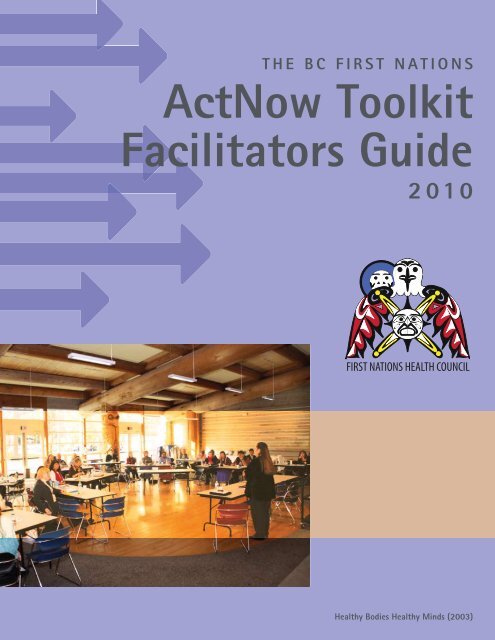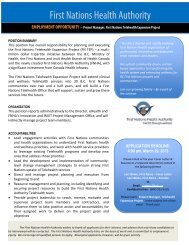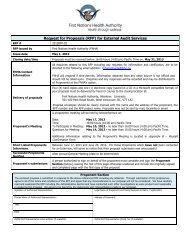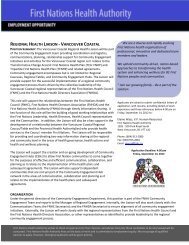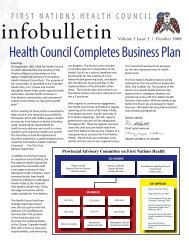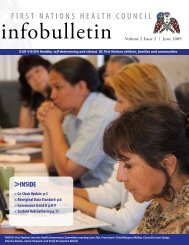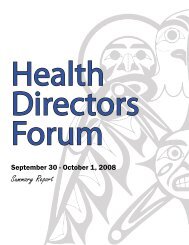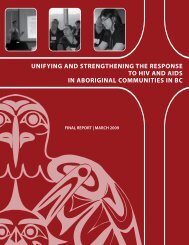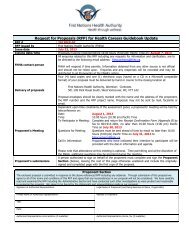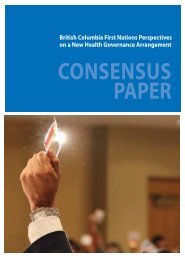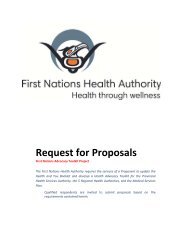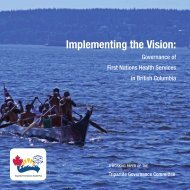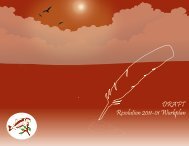actNow Toolkit Facilitators Guide - First Nations Health Council
actNow Toolkit Facilitators Guide - First Nations Health Council
actNow Toolkit Facilitators Guide - First Nations Health Council
- No tags were found...
You also want an ePaper? Increase the reach of your titles
YUMPU automatically turns print PDFs into web optimized ePapers that Google loves.
Pre-Workshop Preparation ChecklistHost <strong>First</strong> Nation ArrangementsSchedule dateDiscuss participant numbers and backgroundsDiscuss room set upEnsure availability of 3 flipchart stands and paperBook accommodations – host recommendations, <strong>First</strong> Nation owned businessesBook travel & receive any local tips – e.g. route cautions, ferry schedulesEnquire about protocols – prayer, acknowledgements of members, acknowledgementsof territoryDetermine if there will be a host introductory speaker or opening prayer.MaterialsSession Invite – edit photos, date, location, contact informationTopic Posters – edit photosProvide Session Invite and Topic Posters to hostPhotocopy:• <strong>Toolkit</strong>• Agenda• Program Needs Assessment Worksheet• Program Needs AssessmentInstruction Sheet• Setting Priorities Worksheet• Setting Objectives Worksheet• At A Glance – Put it into Action• Work Plan Template• Work Plan Sample• Evaluation FormFlipchart markers and masking tapePowerPointCover page & Day 2 Cover – edit community name and session dateEdit photos as appropriateEnsure availability of a laptop, projector, screen and extension cordPre-Day 2 Workshop PreparationMake a digital copy of the Needs Assessment, Priorities and Objectives worksheetsMake a digital copy of the Needs Assessment, Priorities and Objectives worksheetsPrepare summary notes of Concerns, Priorities and ObjectivesTranscribe flipcharts from the Ice BreakerPrepare Work Plans for each topicPrepare PowerPoint slides of the Work PlansPrint and copy Work Plans for participantsPage 2
Agenda TopicSummary of Session Goals & FormatTimePurposePreparationActivity15 minutesOutline what participants can expect to achieve during the session, and describe the methods ofparticipation during the session.Prior to the SessionPhotocopy agendas for all participants.At the SessionPowerPoint slide of session agenda highlights.Over the next day and a half, we will be starting to develop a plan to increase orenhance health and wellness in your community. This action plan will identify programsor activities that you can use, based on your community’s needs and interests. Theseprograms or activities might be for individuals or groups, youth, young mothers orelders, and might be delivered in the school, workplace, community hall, or even athome.<strong>Health</strong> and wellness requires a holistic approach. For example, research shows that achild’s ability to learn is related to good nutrition. To support proper nutrition at bothhome and in the schools, this might require education material being provided inhomes, a community garden, or a healthy snack cupboard at school. These programsrequire the involvement of parents, teachers, the leadership and even the local grocerystore. As you can see, everyone in the community has a role to play. This is the reason adiverse group from your community has been invited here today.Today’s session will be about “assessing” and “prioritizing”. Our discussions will beorganized around three themes: <strong>Health</strong>y Eating, Physical Fitness, and TraditionalWellness. This morning, we’ll go through a community needs assessment. You willbe asked to consider: “What are the areas of health and wellness that we are mostconcerned about?” “Which members of our community are most at risk (e.g. fordiabetes, obesity, heart disease, cancer)?”After lunch we’ll move to the “prioritizing” phase of our session. This morning’sdiscussion is bound to generate a long list of needs. But, given the reality of resourceslimits in the community (both human and financial resources), which needs are mostcritical? This doesn’t mean that we ignore the other needs, but where do we want tostart first?Next, we’ll spend a bit of time talking about “objectives” – that is, we’ve identified aconcern, now what does our desired future condition look like?Tomorrow, we’ll look at how to start working towards the objectives you’ve identifiedusing things like an ActNow Committee, and the <strong>Toolkit</strong> resources. These resourcesinclude educational materials, activity ideas, and potential funding sources.By the end of the session, you will have the start of an action plan that you can continueworking on, as well as some facilitation tools that you can use when working toimplement a particular health and wellness initiative.Let’s get started!Page 6
Agenda TopicCommunity Needs AssessmentTimePurposePreparationActivity60 minutes – issue identification45 minutes – program gap identificationThe overall intent of the Needs Assessment is to help the community decide where to bestfocus their efforts. This means discussing “who” in the community needs assistance, and“what” the issues are. “How” this gets done is the focus of Day 2.Discuss “what is” and “what should be” in the community for each of the key areas: <strong>Health</strong>yEating, Physical Fitness, and Traditional Wellness.Determine what the areas of concern are for the community, and determine it, or howwell, programs are addressing these concerns.Prior to the Session• Photocopy the Program Needs Assessment Worksheet (2 copies per participant,with extras available)At the Session• Hand out the photocopies• PowerPoint slides for Needs AssessmentFacilitate the group by asking the following question: “What are your major concerns?Give examples of what you are seeing / hearing / experiencing that causes you concern.”Ask the group to keep in mind the various age groups or social groups within theircommunity. For example:• Babies /pre-school children• Pregnant women or new mothers• Elementary / middle school children • Elders• High school aged youth(If facilitator is also a community member, he/she should advise the group that everyresponse is a good response and that the group’s responses in no way will offend thefacilitator as we are all working together to create a healthier community.)Record comments on the flipchart, or use the projector and record comments onthe worksheet. Participants can keep their own notes on the worksheets as well. Askthe group not to prioritize their concerns, or dismiss concerns that are not shared byeveryone. Ask them to use this time to just air all of their concerns.Assign approximately 20 minutes for each of the three topic areas. Tell the groups not toworry about running out of time. This workshop is only a beginning, and the work donetoday can be added to or refined in the future.Take a break after 60 minutes.For the second part of the exercise, ask the group to consider if there are any programs,activities or initiatives in their community aimed at addressing each concern. If using theworksheet, check one of the boxes: Yes, Needs Improvement, or Gap.“Yes” means there is an adequate program in place.“Needs Improvement” means there is a program in place, however it could be moreeffective.“Gap” means there is no program in place.If the group indicates “Needs Improvement”, ask the group to describe what needs to beadded or changed in the program to make it more effective at addressing the concern.Record their response in the final column of the worksheet.Wrap up this exercise and break for lunch.<strong>First</strong> <strong>Nations</strong> <strong>Health</strong> <strong>Council</strong> ActNow ToolKit <strong>Facilitators</strong> <strong>Guide</strong> Page 7
Agenda TopicSetting PrioritiesTimePurposePreparationActivity1 hour 15 minutesDetermine which needs are most critical, or which needs will be addressed first (e.g. because ofavailable resources, or to start small to gain momentum).Prior to the session• Photocopy the Priorities worksheet. Provide one per participant so allparticipants can keep notes.At the session• Hand out the photocopies• PowerPoint slides for PrioritiesTransfer the Issues in column 1 of the Needs Assessment worksheet into column 1 ofthe Setting Priorities worksheet. Then have the group discuss what priority each needshould receive.Priority may be assigned based on criteria such as:• What is most critical (e.g. poses the highest risk)• Whether there are known resources available• Starting small to ensure success that can be built on to gain momentum.Tell the group that they can assign priorities based on any criteria they deem relevant.Record the group’s rationale on the worksheet in column 2, and finally have themassign a priority number (1 being the highest) in column 3. If there were a large numberof needs identified (e.g. 10+), the group may choose to prioritize all needs, or stop afterthey have identified their top 3. Participants can come to a consensus on the priorities,or each can indicate their “vote”.Explain that the “voting” is only to show the relative support for a particular need. Thisdoes not “bind” the community to act on a priority, since additional planning work willbe needed first.Agenda TopicClosing CommentsTimePurposePreparationActivity15 minutesSummarize the day’s activities, announce the start time for Day 2, and open the floor for anyquestions.NoneToday has been spent discussing what the areas of concern are for the communityin terms of health and wellness, and what you want to achieve in terms of futureimprovements or results. Tomorrow our focus will be on tools and resources that canbe used to help you reach your objectives. Remember, this is only a beginning. You cantake the exercises used today to work through these issues in greater detail, or withother members of your community at a later date.Any questions? Thanks for your good work and participation today.We’ll close the day with a prayer.Page 8
Agenda TopicSession Welcome,Day 1 Summary, Day 2 OverviewTimePurposePreparationActivity30 minutesOpening prayerRecap Day 1, and outline the Day 2 agendaReview the group worksheets from Day 1, and prepare a few notes to highlight some of theconcerns, priorities and objectives from each group.Good morning. To open our session today, __________ will start us off with a prayer.Yesterday was spent discussing the concerns that you have related to <strong>Health</strong>y Eating,Physical Fitness, and Traditional Wellness. The top priorities that were identifiedincluded: ____________________.You then identified some objectives for these priorities. These included: ___________.Today, we’re going to discuss and look at some tools and resources, identified withinthe ActNow <strong>Toolkit</strong>, that you can use as a community to work towards your objectives.These tools will include a work plan framework, the concept of an ActNow committee,as well as specific activities, web based information, and funding sources.Agenda Topic<strong>Toolkit</strong> ResourcesTimePurposePreparationActivity60 minutesIntroduce the key components of the toolkit – Roles, Put it Into Action activities, References.Prior to the SessionPhotocopy the At A Glance summary sheet - one per participantPhotocopy the <strong>Toolkit</strong> – one per participantAt the SessionPowerPoint slides for <strong>Toolkit</strong> ResourcesWalk the participants through the key sections of the <strong>Toolkit</strong>:• Roles – involvement of the whole community is a key part of any health andwellness promotion program. Select a few points from each of the Roles tohighlight as examples• Traditional wellness has been placed throughout the toolkit• General healthy eating guidelines• General physical activity guidelines• Getting Started– this workshop designed for this section• Put it Into Action – ideas and activities to implement in your community.Includes Steps to follow as well as References and Resourceso <strong>Health</strong> Eatingo Physical Fitnesso Traditional Wellness• Additional web resourcesReview some of the issues and objectives from Day 1 and discuss Put it Into Actionactivities that could help address the objectives. Track these on the flipcharts.<strong>First</strong> <strong>Nations</strong> <strong>Health</strong> <strong>Council</strong> ActNow ToolKit <strong>Facilitators</strong> <strong>Guide</strong> Page 9
Agenda TopicCommunity ResourcesTimePurposePreparation60 minutesDiscuss the concept of an ActNow Committee, and discuss existing resources within thecommunity.PowerPoint slides for Internal ResourcesA committee or group will be needed to plan, implement or oversee, and monitor yourchosen activities. The membership of your committee can vary depending on the natureof the activity, and the availability, interest and skills of community members or staff.You might choose to form one overarching committee that plans all ActNow activities.This approach makes it easy to see the synergies and connections between <strong>Health</strong>yEating, Physical Fitness and Traditional Wellness. There could then be subcommitteesthat focus on particular initiatives. Alternately, you could have one committee for eachof <strong>Health</strong>y Eating, Physical Fitness and Traditional Wellness, also with subcommittees, ifneeded, for implementation.Discussion QuestionsActivity• Are there existing committees or groups in your community that could serve therole of initiating ActNow activities:o In their current formo With additions or restructuring• What changes would be needed?• Do you need to start a new committee?• One overarching committee that looks at healthy eating, physical fitness,traditional wellness?• Subcommittees that implement each area, work on individual initiatives• Who are people within your community that would be good “champions” or“catalysts” or “role models”?• Do you have a current committee structure as part of your governance model?o What are the reporting/accountability/liability considerations?• Think about your or others’ ability to serve on the committeeo conflict of interesto time to commito part of your work - dayo volunteer – evenings/weekendsRecord the discussion on the flipcharts.Page 10
Agenda TopicReview of the Work Plan FrameworkTimePurposePreparation30 minutesNote: If a full 2 day session is planned, this section could be expanded by preparinginitial workplans for each of the priorities identifiedReview each of the work plan components and provide tips on completing the plan.On the evening of Day 1, utilize the group worksheets to fill in sample work plans. Try to completea sample for each of the three groups. Print and photocopy these on the morning of Day 2.Prepare a PowerPoint slide of the sample work plans.A Work Plan template has been developed to help organize and track yourimplementation of activities initiated to meet your objectives.The identified concern from your Needs Assessment gets summarized at the top of thesheet. Next, the objective gets written.In the table, the following columns are included:Activity• Activity / Initiative – e.g. projects from the <strong>Toolkit</strong>• Who is taking the lead – a staff member, teacher etc. This could be a team ofpeople.• Partners – a group external to your office/committee that is assisting with theproject (local, regional, provincial, national)• Resources – educational material, web links, etc. that you can consult and use• Budget – In-kind or cash amounts, along with sources (existing operationalbudget, fundraising, funding applications / proposals)• Timeframe – key milestones• Monitoring – measures of success (e.g. numbers of workshops, % weight lost,number of youth enrolled in program), and targets (the desired amount)Finally, there is a section to detail the steps taken to implement the project.This template is only an example, and can be amended to suit your needs.Show example of completed work plan.Complete a sample work plan for one of the group’s issues if time allows.<strong>First</strong> <strong>Nations</strong> <strong>Health</strong> <strong>Council</strong> ActNow ToolKit <strong>Facilitators</strong> <strong>Guide</strong> Page 11
NotesPage 12
1205 - 100 Park Royal SouthWest Vancouver, BCV7T 1A2Toll - Free in BC: 1.866.913.0033T: 604.913.2080


